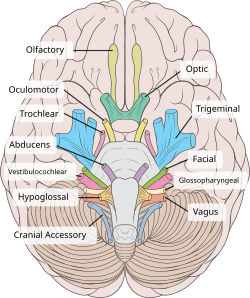Hypoglossal nerve
| Hypoglossal nerve | |
|---|---|

Hypoglossal nerve, cervical plexus, and their branches.
|
|

The hypoglossal nerve arises as a series of rootlets, from the caudal brain stem, here seen from below.
|
|
| Details | |
| To | ansa cervicalis |
| Innervates | genioglossus, hyoglossus, styloglossus, geniohyoid, thyrohyoid, intrinsic muscles of the tongue |
| Identifiers | |
| Latin | nervus hypoglossus |
| MeSH | A08.800.800.120.330 |
| TA | A14.2.01.191 |
| FMA | 50871 |
|
Anatomical terms of neuroanatomy
[]
|
|
The hypoglossal nerve is the twelfth cranial nerve, and innervates all the extrinsic and intrinsic muscles of the tongue, except for the palatoglossus. It is solely a motor nerve. The nerve arises from the hypoglossal nucleus in the brain stem as a number of small rootlets, passes through the hypoglossal canal and down through the neck, and eventually passes up again over the tongue muscles it supplies into the tongue. There are two hypoglossal nerves in the body: one on the left, and one on the right.
The nerve is involved in controlling tongue movements required for speech and swallowing. Lesions or damage to the nerve or the neural pathways which control it can affect the ability of the tongue to move and its appearance.
The name hypoglossus springs from the fact that its passage is below the tongue, hypo meaning "under", and glossus meaning "tongue", both of which are from Ancient Greek.
The hypoglossal nerve arises from the hypoglossal nucleus near the bottom of the brain stem. It begins as a number of smaller rootlets emerging from the front of the medulla in the preolivary sulcus, which separates the olive and the pyramid. The nerve passes through the subarachnoid space and exits the skull and its base through the hypoglossal canal.
After emerging from the hypoglossal canal, it gives off a small meningeal branch and picks up a branch from the anterior ramus of C1. It then travels close to the vagus nerve and spinal division of the accessory nerve, spirals behind the vagus nerve and passes between the internal carotid artery and internal jugular vein lying on the carotid sheath. After passing deep to the posterior belly of the digastric muscle, it passes to the submandibular region, passes upwards and anteriorly on the hyoglossus muscle, and deep to the stylohyoid muscle and lingual nerve. It then passes up on the outer side of the genioglossus muscle and continues in a forward direction to the tip of the tongue. It distributes branches to the intrinsic and extrinsic muscle of the tongue innervates as it passes in this direction.
...
Wikipedia
